# unmixer - create and explore isolated tracks from music files
[](https://pypi.org/project/unmixer/) [](https://www.python.org/downloads/) [](https://pypi.org/project/unmixer/) [](https://github.com/will2dye4/unmixer/blob/master/LICENSE)
`unmixer` is a graphical utility and Python package for creating isolated tracks
(drums, bass, vocals, etc.) from music files.
`unmixer` is a frontend for [`demucs`](https://github.com/facebookresearch/demucs),
an excellent command-line utility for music source separation from the
[Meta Research](https://opensource.fb.com) team. The creation of isolated tracks
is handled entirely by `demucs`; `unmixer` provides a graphical interface for
viewing, playing, and exporting the isolated tracks in any combination.
## Installation
The easiest way to install the package is to download it from [PyPI](https://pypi.org) using `pip`.
Note that `unmixer` depends on [Python](https://www.python.org/downloads/) 3.11 or newer; please
ensure that you have a recent version of Python installed before proceeding.
Run the following command in a shell (Linux or macOS is assumed):
```
$ pip install --upgrade unmixer
```
The package does depend on a few external Python packages available on PyPI. If you wish to
sandbox your installation inside a virtual environment, you may choose to use
[virtualenvwrapper](https://virtualenvwrapper.readthedocs.io/en/latest/) or a similar
utility to do so.
When successfully installed, a program called `unmixer` will be placed on your `PATH`. See the
Usage section below for details about how to use this program.
### Dependencies
* The utility expects [`ffmpeg`](https://ffmpeg.org) to be installed for mixing isolated
tracks. See the project's [Downloads](https://ffmpeg.org/download.html) page for
instructions on downloading and installing `ffmpeg`.
## Usage
The `unmixer` program is a graphical utility for exploring isolated tracks extracted
from a music file.
At any time, you can use the `-h` or `--help` flags to see a summary of options that
the program accepts.
```
$ unmixer -h
usage: unmixer [-h] [music_file_or_track_dir]
create and explore isolated tracks from music files
positional arguments:
music_file_or_track_dir
path to the file to unmix, or path to a directory containing isolated tracks
options:
-h, --help show this help message and exit
```
### Creating Isolated Tracks
To create isolated tracks for a specific song, pass the path to the song to `unmixer`.
For example:
```
$ unmixer /path/to/Limelight.mp3
```
When invoked with no arguments, `unmixer` will open a Song Importer window containing
a button labeled `Explore isolated tracks...` and another button labeled `Choose a song...`
(see the screenshot below). The Song Importer window may also be opened at any time using
the keyboard shortcut `Ctrl+0` (`Cmd+0` on macOS).
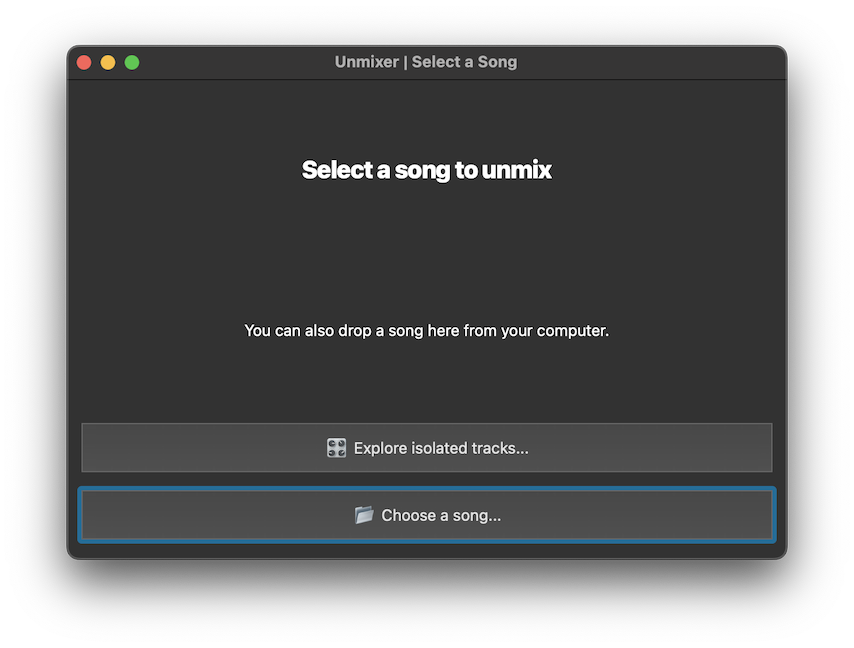
Press the `Choose a song...` button and select a music file that you want to create
isolated tracks from. Alternatively, you may drag a music file from elsewhere on your computer
and drop it on the Song Importer window. When a song has been selected, the interface will
change to reflect that the song is ready to be processed (see the screenshot below).
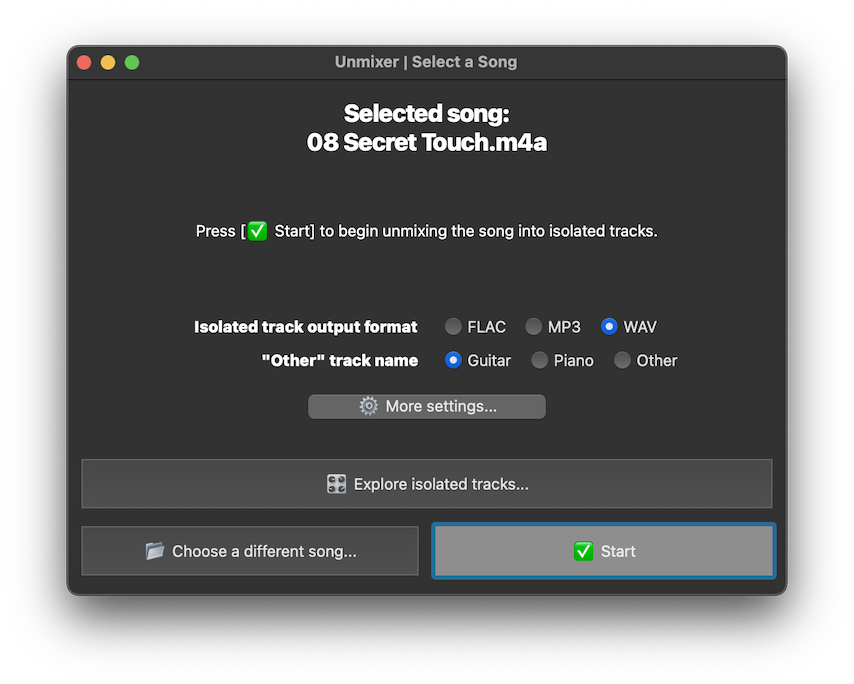
Use the radio buttons to set the desired output format for the isolated tracks (MP3 or WAV)
and the name of the "other" track (see Customizing the "Other" Track Name, below). Press
`More settings...` to customize additional settings such as the output directory, prediction
model, and so on.
If you selected the wrong song by mistake, press `Choose a different song...` to select a
different file. When you are ready to unmix the song into isolated tracks, press the `Start`
button at the bottom right of the Song Importer window. The interface will change to reflect
that the song is being processed (see the screenshot below).
Once processing has started, the `Start` button will change to a `Cancel` button; use this
button to abandon processing of the song.
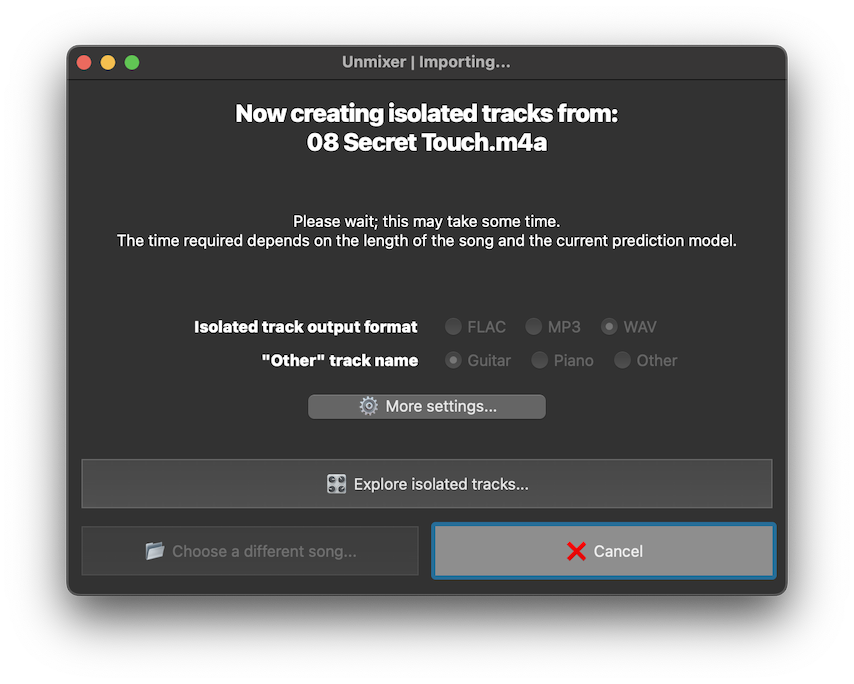
**Please be patient during the process of creating the isolated tracks**, as it will
take some time to complete! The time required largely depends on the length of the source
song, the selected prediction model, and other factors such as whether your device
supports GPU acceleration or the configured parallelism. As a baseline, with no GPU
acceleration and a single CPU process, it typically takes about as long as the source song
itself (or a bit longer) to create the isolated tracks for a song. For example, if a song
is 5 minutes long, it will likely take roughly 5 minutes to create isolated tracks for
that song.
**NOTE:** Although `unmixer` does not display a progress bar in its graphical interface
showing the status of processing the song, the progress will be shown in the process's
standard output (assuming the standard output is not redirected to a file). Check the
shell or terminal from which you launched the `unmixer` UI to get a better approximation
of how long it will take to process the song. A visual progress bar may be added in
a future version.
#### Output Format
By default, isolated tracks are created as WAV files for the highest quality. To create
FLAC or MP3 files instead, use the **Isolated track output format** radio buttons in the
Song Importer window to select the desired format.
**NOTE:** Mixes exported using the Track Explorer (see below) will use the same format
as the source isolated track files.
**NOTE:** If you selected an output format other than WAV, replace the `.wav` file extension
in the following sections with the appropriate extension (`.flac` or `.mp3`).
#### Output Tracks
The following isolated tracks are created by default:
* `bass.wav`
* `drums.wav`
* `other.wav`
* `vocals.wav`
These are the sources that are supported by `demucs`; unfortunately, there is currently
no specific source available for guitar, piano, or any others besides bass, drums, and
vocals. Any part of the song's audio that is not identified as bass, drums, or vocals
will be found in the `other.wav` file.
**NOTE:** `demucs` does include one pre-trained model, `htdemucs_6s`, which includes guitar
and piano as additional sources. This model is still in an experimental stage and does not
perform reliably at separating all sources.
#### Customizing the "Other" Track Name
In some cases, the isolated track `other.wav` may contain primarily a single instrument,
such as a guitar or piano. In these cases, it may be useful for the resulting output track
to have a corresponding name such as `guitar.wav` or `piano.wav` instead of the
default `other.wav`.
To change the name of the "other" track to `guitar.wav` or `piano.wav`, use the
**"Other" track name** radio buttons in the Song Importer window to select the desired name.
It is not currently possible to customize the name of the "other" track to be any arbitrary name,
although this feature may be added in a future version.
#### Output Directory
By default, `unmixer` creates isolated tracks in subdirectories of the directory `~/unmixer`.
Each song's isolated tracks will be placed in a new subdirectory of the output directory
named based on the selected prediction model and the song's filename. For example, isolated tracks
for a song named `Subdivisions.mp3` created using the model `htdemucs` would be placed in the
directory `~/unmixer/htdemucs/Subdivisions` by default (note that the subdirectory does not include
the `.mp3` file extension).
**NOTE:** Creating isolated tracks for multiple songs with the same filename using the same model
will result in any previous songs' isolated tracks being overwritten! If you need to process
multiple distinct songs with the same filename, be sure to rename the created directories (or
rename the song files themselves) to avoid conflicts!
To customize the output directory for isolated tracks, press `More settings...` in the Song
Importer window and adjust the `Output directory` setting in the Unmixer Preferences window
that opens. You may also enable or disable creation of a subdirectory named for the selected
prediction model. A subdirectory of the selected output directory will be created for each
song's isolated tracks, as described above.
#### Other Settings
To see all customizable settings, press `More settings...` in the Song Importer window after
selecting a song. The Unmixer Preferences window will appear (see the screenshot below).
Hover over each setting's label to see a description of that setting in the status bar at
the bottom of the Unmixer Preferences window. See the
[demucs docs](https://github.com/facebookresearch/demucs/tree/main#separating-tracks) for
details about settings such as clip mode, segmentation of input songs, and so on.
Changes made to the settings are saved automatically; however, changes made to settings while
a song is being processed will not take effect until the next time a song is imported. Press
`Restore Defaults` at the bottom of the Unmixer Preferences window to revert all settings
to their default values.

**NOTE:** Some settings may not be available or have limited configurability depending on the
selected prediction model. For example, the `htdemucs` family of models has a maximum segment
length of 7.8 seconds, so `unmixer` requires that songs processed using this model be split into
segments with a maximum segment length of no more than 7 seconds (since `demucs` accepts the
segment length as an integer). Similarly, `unmixer` does not allow customizing the "other"
track name when using the `htdemucs_6s` model because this model already includes guitar and piano
as distinct sources.
### Exploring Isolated Tracks
To explore isolated tracks located in a specific directory, pass the path to the directory to
`unmixer`. For example:
```
$ unmixer ~/unmixer/YYZ
```
Alternatively, press the `Explore isolated tracks...` button in the Song Importer window
(see above) and select a directory containing isolated tracks. You may also drop a directory
containing isolated tracks onto the Song Importer window to open a Track Explorer window for
that directory.
**NOTE:** If you used `unmixer` to create isolated tracks for a song, the Track Explorer window
will open automatically when the song is finished processing, unless you disabled that setting.
(Again...please be patient!)
The Track Explorer window displays the name of the song at the top, a set of playback controls
at the bottom, and a waveform and a set of controls for each isolated track found in the input
directory (see the screenshot below).
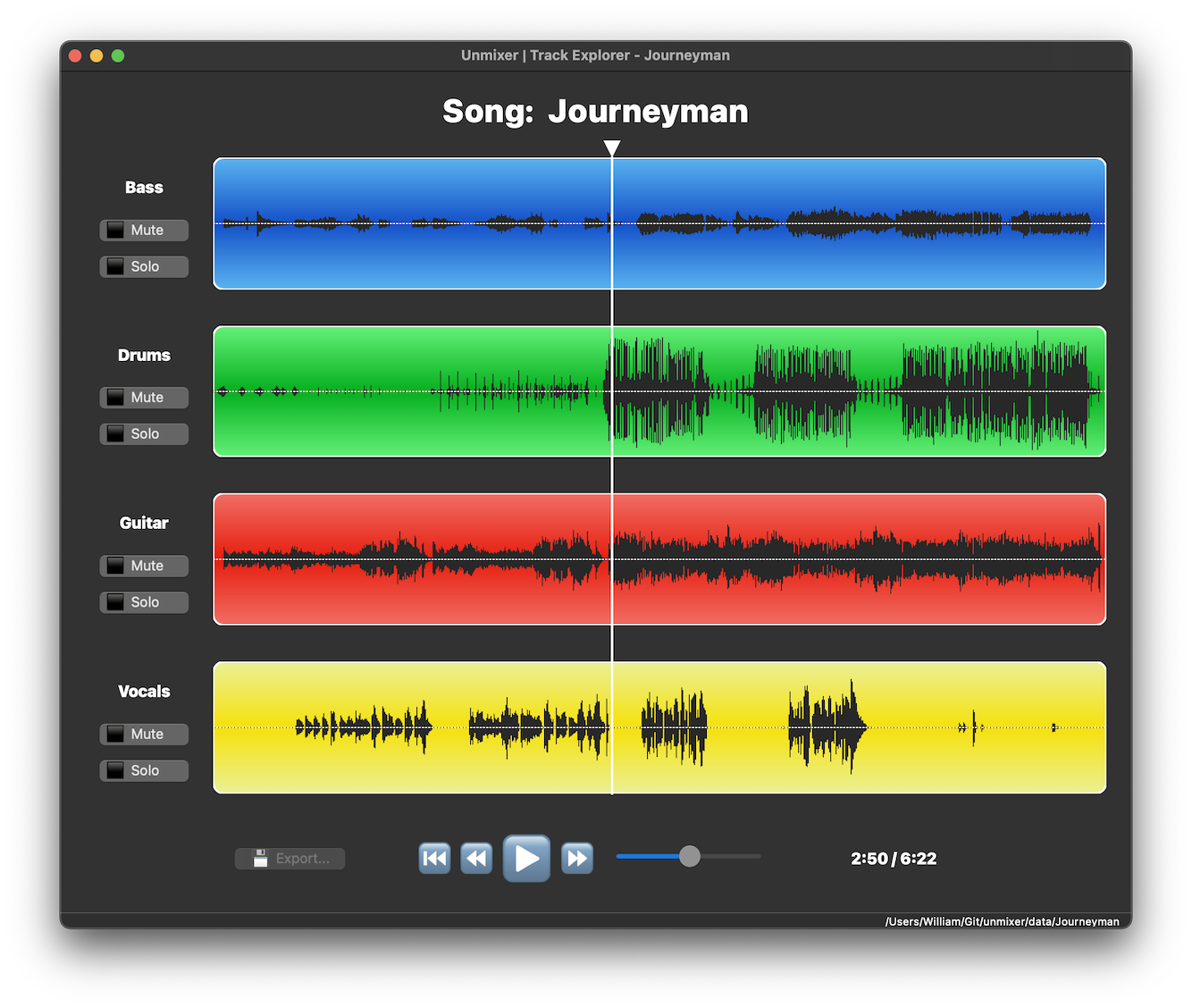
#### Playback Controls
Use the ▶️ (Play) / ⏸️ (Pause) button found in the playback controls at the bottom of the
Track Explorer window (or press the Space bar) to control playback of the currently selected
track(s). Press the ⏮️ (Restart) button to start playback at the beginning of the song. Press
the ⏪️ (Skip Back) button to skip back one second at a time; press and hold the button to
repeatedly skip back until the button is released. Press the ⏩️ (Skip Forward) button to skip
forward one second at a time; press and hold the button to repeatedly skip forward until the
button is released. The left and right arrow keys may also be used to skip back and forward,
respectively.
Use the volume slider to the right of the playback controls to adjust the playback volume of the
currently selected tracks. Alternatively, the keyboard shortcuts `Ctrl+Up` and `Ctrl+Down`
(`Cmd+Up` and `Cmd+Down` on macOS) may be used to raise and lower the volume, respectively.
Note that the underlying isolated track files themselves are NOT modified. `unmixer` does not
currently provide a way to adjust the relative volume levels of the various isolated tracks in the
overall mix, although this feature may be added in a future version.
When the song is playing, you can drag the triangular playhead (displayed above the very topmost
track, with a white line extending down over all of the waveforms) to skip to a specific part of
the song. Dragging the playhead while the song is paused is not currently supported.
#### Track Controls
Each track has its own `Mute` button and `Solo` button displayed to the left of the track's
waveform. Use a track's `Mute` button to remove that track from the mix you hear when playing
the song. Inversely, use a track's `Solo` button to hear **only** that track when playing
the song. As the name implies, only one track may have the `Solo` button active at a time.
A track may not be both soloed and muted at the same time; soloing a muted track will unmute
the track automatically. Playback will pause automatically if all tracks are muted at the
same time.
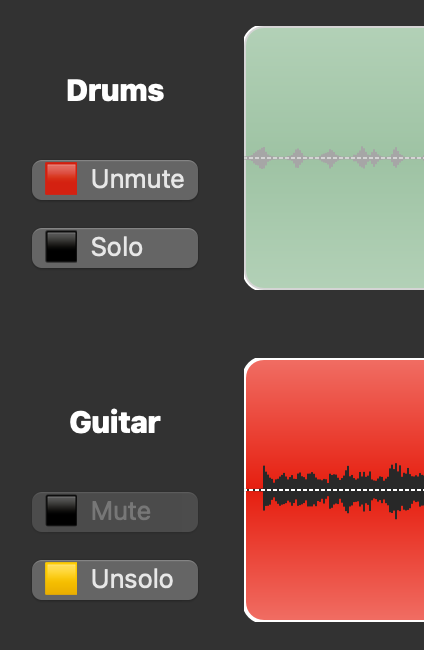
#### Exporting a Custom Mix
Use the `Export...` button found in the playback controls at the bottom of the Track Explorer
to export the currently selected (i.e., unmuted) tracks as a new file. A dialog box will open,
allowing you to select a destination for the file and press `Save`. For example, to create an
instrumental mix of a song, mute the `Vocals` track and export the remaining tracks as a new mix.
**NOTE:** Exporting is disabled when only a single track is selected, since that single track
is already a self-contained file that does not need to be re-exported. Similarly, exporting is
also disabled when all tracks are selected, since the resulting mix is the same as the original
song file that produced the isolated tracks in the first place.
If you export custom mixes in the same directory where the isolated tracks are located, the
custom mixes will also be loaded if you reopen the same directory using `unmixer` in the future.
If you want to avoid this, save any custom mixes to a different directory, such as a `remixes`
subdirectory of the directory where the isolated tracks are located.
Raw data
{
"_id": null,
"home_page": "https://github.com/will2dye4/unmixer.git",
"name": "unmixer",
"maintainer": "",
"docs_url": null,
"requires_python": ">=3.11,<3.13",
"maintainer_email": "",
"keywords": "demux,demux music,music source separation,split,split music,unmix,unmix music,unmixer",
"author": "William Dye",
"author_email": "",
"download_url": "https://files.pythonhosted.org/packages/f9/89/3aca4de42ea35e8884d8b42949f15e4def0b7dce8cac9c5950095443b7bd/unmixer-1.2.0.tar.gz",
"platform": null,
"description": "# unmixer - create and explore isolated tracks from music files\n\n[](https://pypi.org/project/unmixer/) [](https://www.python.org/downloads/) [](https://pypi.org/project/unmixer/) [](https://github.com/will2dye4/unmixer/blob/master/LICENSE)\n\n`unmixer` is a graphical utility and Python package for creating isolated tracks\n(drums, bass, vocals, etc.) from music files.\n\n`unmixer` is a frontend for [`demucs`](https://github.com/facebookresearch/demucs),\nan excellent command-line utility for music source separation from the\n[Meta Research](https://opensource.fb.com) team. The creation of isolated tracks\nis handled entirely by `demucs`; `unmixer` provides a graphical interface for\nviewing, playing, and exporting the isolated tracks in any combination.\n\n## Installation\n\nThe easiest way to install the package is to download it from [PyPI](https://pypi.org) using `pip`.\nNote that `unmixer` depends on [Python](https://www.python.org/downloads/) 3.11 or newer; please\nensure that you have a recent version of Python installed before proceeding.\n\nRun the following command in a shell (Linux or macOS is assumed):\n\n```\n$ pip install --upgrade unmixer\n```\n\nThe package does depend on a few external Python packages available on PyPI. If you wish to\nsandbox your installation inside a virtual environment, you may choose to use\n[virtualenvwrapper](https://virtualenvwrapper.readthedocs.io/en/latest/) or a similar\nutility to do so.\n\nWhen successfully installed, a program called `unmixer` will be placed on your `PATH`. See the\nUsage section below for details about how to use this program.\n\n### Dependencies\n\n* The utility expects [`ffmpeg`](https://ffmpeg.org) to be installed for mixing isolated\n tracks. See the project's [Downloads](https://ffmpeg.org/download.html) page for\n instructions on downloading and installing `ffmpeg`.\n\n## Usage\n\nThe `unmixer` program is a graphical utility for exploring isolated tracks extracted\nfrom a music file.\n\nAt any time, you can use the `-h` or `--help` flags to see a summary of options that\nthe program accepts.\n\n```\n$ unmixer -h\nusage: unmixer [-h] [music_file_or_track_dir]\n\ncreate and explore isolated tracks from music files\n\npositional arguments:\n music_file_or_track_dir\n path to the file to unmix, or path to a directory containing isolated tracks\n\noptions:\n-h, --help show this help message and exit\n```\n\n### Creating Isolated Tracks\n\nTo create isolated tracks for a specific song, pass the path to the song to `unmixer`.\nFor example:\n\n```\n$ unmixer /path/to/Limelight.mp3\n```\n\nWhen invoked with no arguments, `unmixer` will open a Song Importer window containing\na button labeled `Explore isolated tracks...` and another button labeled `Choose a song...`\n(see the screenshot below). The Song Importer window may also be opened at any time using\nthe keyboard shortcut `Ctrl+0` (`Cmd+0` on macOS).\n\n\n\nPress the `Choose a song...` button and select a music file that you want to create\nisolated tracks from. Alternatively, you may drag a music file from elsewhere on your computer\nand drop it on the Song Importer window. When a song has been selected, the interface will\nchange to reflect that the song is ready to be processed (see the screenshot below).\n\n\n\nUse the radio buttons to set the desired output format for the isolated tracks (MP3 or WAV)\nand the name of the \"other\" track (see Customizing the \"Other\" Track Name, below). Press\n`More settings...` to customize additional settings such as the output directory, prediction\nmodel, and so on.\n\nIf you selected the wrong song by mistake, press `Choose a different song...` to select a\ndifferent file. When you are ready to unmix the song into isolated tracks, press the `Start`\nbutton at the bottom right of the Song Importer window. The interface will change to reflect\nthat the song is being processed (see the screenshot below).\n\nOnce processing has started, the `Start` button will change to a `Cancel` button; use this\nbutton to abandon processing of the song.\n\n\n\n**Please be patient during the process of creating the isolated tracks**, as it will\ntake some time to complete! The time required largely depends on the length of the source\nsong, the selected prediction model, and other factors such as whether your device\nsupports GPU acceleration or the configured parallelism. As a baseline, with no GPU\nacceleration and a single CPU process, it typically takes about as long as the source song\nitself (or a bit longer) to create the isolated tracks for a song. For example, if a song\nis 5 minutes long, it will likely take roughly 5 minutes to create isolated tracks for\nthat song.\n\n**NOTE:** Although `unmixer` does not display a progress bar in its graphical interface\nshowing the status of processing the song, the progress will be shown in the process's\nstandard output (assuming the standard output is not redirected to a file). Check the\nshell or terminal from which you launched the `unmixer` UI to get a better approximation\nof how long it will take to process the song. A visual progress bar may be added in\na future version.\n\n#### Output Format\n\nBy default, isolated tracks are created as WAV files for the highest quality. To create\nFLAC or MP3 files instead, use the **Isolated track output format** radio buttons in the\nSong Importer window to select the desired format.\n\n**NOTE:** Mixes exported using the Track Explorer (see below) will use the same format\nas the source isolated track files.\n\n**NOTE:** If you selected an output format other than WAV, replace the `.wav` file extension\nin the following sections with the appropriate extension (`.flac` or `.mp3`).\n\n#### Output Tracks\n\nThe following isolated tracks are created by default:\n\n* `bass.wav`\n* `drums.wav`\n* `other.wav`\n* `vocals.wav`\n\nThese are the sources that are supported by `demucs`; unfortunately, there is currently\nno specific source available for guitar, piano, or any others besides bass, drums, and\nvocals. Any part of the song's audio that is not identified as bass, drums, or vocals\nwill be found in the `other.wav` file.\n\n**NOTE:** `demucs` does include one pre-trained model, `htdemucs_6s`, which includes guitar\nand piano as additional sources. This model is still in an experimental stage and does not\nperform reliably at separating all sources.\n\n#### Customizing the \"Other\" Track Name\n\nIn some cases, the isolated track `other.wav` may contain primarily a single instrument,\nsuch as a guitar or piano. In these cases, it may be useful for the resulting output track\nto have a corresponding name such as `guitar.wav` or `piano.wav` instead of the\ndefault `other.wav`.\n\nTo change the name of the \"other\" track to `guitar.wav` or `piano.wav`, use the\n**\"Other\" track name** radio buttons in the Song Importer window to select the desired name.\nIt is not currently possible to customize the name of the \"other\" track to be any arbitrary name,\nalthough this feature may be added in a future version.\n\n#### Output Directory\n\nBy default, `unmixer` creates isolated tracks in subdirectories of the directory `~/unmixer`.\nEach song's isolated tracks will be placed in a new subdirectory of the output directory\nnamed based on the selected prediction model and the song's filename. For example, isolated tracks\nfor a song named `Subdivisions.mp3` created using the model `htdemucs` would be placed in the\ndirectory `~/unmixer/htdemucs/Subdivisions` by default (note that the subdirectory does not include\nthe `.mp3` file extension).\n\n**NOTE:** Creating isolated tracks for multiple songs with the same filename using the same model\nwill result in any previous songs' isolated tracks being overwritten! If you need to process\nmultiple distinct songs with the same filename, be sure to rename the created directories (or\nrename the song files themselves) to avoid conflicts!\n\nTo customize the output directory for isolated tracks, press `More settings...` in the Song\nImporter window and adjust the `Output directory` setting in the Unmixer Preferences window\nthat opens. You may also enable or disable creation of a subdirectory named for the selected\nprediction model. A subdirectory of the selected output directory will be created for each\nsong's isolated tracks, as described above.\n\n#### Other Settings\n\nTo see all customizable settings, press `More settings...` in the Song Importer window after\nselecting a song. The Unmixer Preferences window will appear (see the screenshot below).\nHover over each setting's label to see a description of that setting in the status bar at\nthe bottom of the Unmixer Preferences window. See the\n[demucs docs](https://github.com/facebookresearch/demucs/tree/main#separating-tracks) for\ndetails about settings such as clip mode, segmentation of input songs, and so on.\n\nChanges made to the settings are saved automatically; however, changes made to settings while\na song is being processed will not take effect until the next time a song is imported. Press\n`Restore Defaults` at the bottom of the Unmixer Preferences window to revert all settings\nto their default values.\n\n\n\n**NOTE:** Some settings may not be available or have limited configurability depending on the\nselected prediction model. For example, the `htdemucs` family of models has a maximum segment\nlength of 7.8 seconds, so `unmixer` requires that songs processed using this model be split into\nsegments with a maximum segment length of no more than 7 seconds (since `demucs` accepts the\nsegment length as an integer). Similarly, `unmixer` does not allow customizing the \"other\"\ntrack name when using the `htdemucs_6s` model because this model already includes guitar and piano\nas distinct sources.\n\n### Exploring Isolated Tracks\n\nTo explore isolated tracks located in a specific directory, pass the path to the directory to\n`unmixer`. For example:\n\n```\n$ unmixer ~/unmixer/YYZ\n```\n\nAlternatively, press the `Explore isolated tracks...` button in the Song Importer window\n(see above) and select a directory containing isolated tracks. You may also drop a directory\ncontaining isolated tracks onto the Song Importer window to open a Track Explorer window for\nthat directory.\n\n**NOTE:** If you used `unmixer` to create isolated tracks for a song, the Track Explorer window\nwill open automatically when the song is finished processing, unless you disabled that setting.\n(Again...please be patient!)\n\nThe Track Explorer window displays the name of the song at the top, a set of playback controls\nat the bottom, and a waveform and a set of controls for each isolated track found in the input\ndirectory (see the screenshot below).\n\n\n\n#### Playback Controls\n\nUse the \u25b6\ufe0f (Play) / \u23f8\ufe0f (Pause) button found in the playback controls at the bottom of the\nTrack Explorer window (or press the Space bar) to control playback of the currently selected\ntrack(s). Press the \u23ee\ufe0f (Restart) button to start playback at the beginning of the song. Press\nthe \u23ea\ufe0f (Skip Back) button to skip back one second at a time; press and hold the button to\nrepeatedly skip back until the button is released. Press the \u23e9\ufe0f (Skip Forward) button to skip\nforward one second at a time; press and hold the button to repeatedly skip forward until the\nbutton is released. The left and right arrow keys may also be used to skip back and forward,\nrespectively.\n\nUse the volume slider to the right of the playback controls to adjust the playback volume of the\ncurrently selected tracks. Alternatively, the keyboard shortcuts `Ctrl+Up` and `Ctrl+Down`\n(`Cmd+Up` and `Cmd+Down` on macOS) may be used to raise and lower the volume, respectively.\nNote that the underlying isolated track files themselves are NOT modified. `unmixer` does not\ncurrently provide a way to adjust the relative volume levels of the various isolated tracks in the\noverall mix, although this feature may be added in a future version.\n\nWhen the song is playing, you can drag the triangular playhead (displayed above the very topmost\ntrack, with a white line extending down over all of the waveforms) to skip to a specific part of\nthe song. Dragging the playhead while the song is paused is not currently supported.\n\n#### Track Controls\n\nEach track has its own `Mute` button and `Solo` button displayed to the left of the track's\nwaveform. Use a track's `Mute` button to remove that track from the mix you hear when playing\nthe song. Inversely, use a track's `Solo` button to hear **only** that track when playing\nthe song. As the name implies, only one track may have the `Solo` button active at a time.\nA track may not be both soloed and muted at the same time; soloing a muted track will unmute\nthe track automatically. Playback will pause automatically if all tracks are muted at the\nsame time.\n\n\n\n#### Exporting a Custom Mix\n\nUse the `Export...` button found in the playback controls at the bottom of the Track Explorer\nto export the currently selected (i.e., unmuted) tracks as a new file. A dialog box will open,\nallowing you to select a destination for the file and press `Save`. For example, to create an\ninstrumental mix of a song, mute the `Vocals` track and export the remaining tracks as a new mix.\n\n**NOTE:** Exporting is disabled when only a single track is selected, since that single track\nis already a self-contained file that does not need to be re-exported. Similarly, exporting is\nalso disabled when all tracks are selected, since the resulting mix is the same as the original\nsong file that produced the isolated tracks in the first place.\n\nIf you export custom mixes in the same directory where the isolated tracks are located, the\ncustom mixes will also be loaded if you reopen the same directory using `unmixer` in the future.\nIf you want to avoid this, save any custom mixes to a different directory, such as a `remixes`\nsubdirectory of the directory where the isolated tracks are located.\n",
"bugtrack_url": null,
"license": "MIT",
"summary": "Create and explore isolated tracks from music files",
"version": "1.2.0",
"project_urls": {
"Homepage": "https://github.com/will2dye4/unmixer.git",
"Repository": "https://github.com/will2dye4/unmixer.git"
},
"split_keywords": [
"demux",
"demux music",
"music source separation",
"split",
"split music",
"unmix",
"unmix music",
"unmixer"
],
"urls": [
{
"comment_text": "",
"digests": {
"blake2b_256": "1bd61d7ed6f14f2f25e77594fd9340315e983ccb68e73bce8dcf0c1d2cf07f5a",
"md5": "2470b7e92a789cf9141439be64e0da2a",
"sha256": "35fc91c2dbb84baacd91b85936a6a9921978bdbf0d9093eb501f84f6e126f083"
},
"downloads": -1,
"filename": "unmixer-1.2.0-py3-none-any.whl",
"has_sig": false,
"md5_digest": "2470b7e92a789cf9141439be64e0da2a",
"packagetype": "bdist_wheel",
"python_version": "py3",
"requires_python": ">=3.11,<3.13",
"size": 41350,
"upload_time": "2023-10-26T15:49:27",
"upload_time_iso_8601": "2023-10-26T15:49:27.525462Z",
"url": "https://files.pythonhosted.org/packages/1b/d6/1d7ed6f14f2f25e77594fd9340315e983ccb68e73bce8dcf0c1d2cf07f5a/unmixer-1.2.0-py3-none-any.whl",
"yanked": false,
"yanked_reason": null
},
{
"comment_text": "",
"digests": {
"blake2b_256": "f9893aca4de42ea35e8884d8b42949f15e4def0b7dce8cac9c5950095443b7bd",
"md5": "dd8e149602f20309759b1cbd2db93948",
"sha256": "6d3de5756a674ead3dc0fa9a37ff11c4a641aba3c25ee6f93612f8ca87e74e9f"
},
"downloads": -1,
"filename": "unmixer-1.2.0.tar.gz",
"has_sig": false,
"md5_digest": "dd8e149602f20309759b1cbd2db93948",
"packagetype": "sdist",
"python_version": "source",
"requires_python": ">=3.11,<3.13",
"size": 40530,
"upload_time": "2023-10-26T15:49:28",
"upload_time_iso_8601": "2023-10-26T15:49:28.918896Z",
"url": "https://files.pythonhosted.org/packages/f9/89/3aca4de42ea35e8884d8b42949f15e4def0b7dce8cac9c5950095443b7bd/unmixer-1.2.0.tar.gz",
"yanked": false,
"yanked_reason": null
}
],
"upload_time": "2023-10-26 15:49:28",
"github": true,
"gitlab": false,
"bitbucket": false,
"codeberg": false,
"github_user": "will2dye4",
"github_project": "unmixer",
"travis_ci": false,
"coveralls": false,
"github_actions": false,
"lcname": "unmixer"
}
